Parameter Optimization and Impacts on Oilseed Rape (Brassica napus) Seeds Aerial Seeding Based on Unmanned Agricultural Aerial System
Abstract
1. Introduction
2. Materials and Methods
2.1. Experimental Site, UAAS
2.2. Experimental Materials
2.3. Experimental Treatments
2.3.1. Experiment Design
2.3.2. Sampling Arrangements
2.4. Evaluation Methods of EBSW, BSD and BSU
2.5. Evaluation Method of OSR Seed Germination Rate
3. Results
3.1. Test Data Statistics
3.2. EBSW Analysis
3.2.1. EBSW Changes
3.2.2. Effects of FS and FH on EBSWs
3.3. BSD Analysis
3.3.1. BSD Changes
3.3.2. Effects of FS and FH on BSDs
3.4. BSU Analyses
3.5. OSR Seed Germination Rate
4. Conclusions and Discussion
Author Contributions
Funding
Institutional Review Board Statement
Informed Consent Statement
Data Availability Statement
Conflicts of Interest
References
- Liu, Q.; Ren, T.; Zhang, Y.; Li, X.; Cong, R.; Liu, S.; Fan, X.; Lu, J. Evaluating the application of controlled release urea for oilseed rape on Brassica napus in a regional scale: The optimal usage, yield and nitrogen use efficiency responses. Ind. Crop. Prod. 2019, 140, 111560. [Google Scholar] [CrossRef]
- Lu, J. Scientific Fertilization Technology for Oilseed Rape; God Shield Press: Beijing, China, 2010. [Google Scholar]
- Delgado, M.; Felix, M.; Bengoechea, C. Development of bioplastic materials: From rapeseed oil industry by products to added-value biodegradable biocomposite materials. Ind. Crop. Prod. 2018, 125, 401–407. [Google Scholar] [CrossRef]
- Szubert, K. Synthesis of organofunctional silane from rapeseed oil and its application as a coating material. Cellulose 2018, 25, 6269–6278. [Google Scholar] [CrossRef]
- Shim, Y.; Falk, K.; Ratanapariyanuch, K.; Reaney, M.J.T. Food and fuel from Canadian oilseed grains: Biorefinery production may optimize both resources. Eur. J. Lipid Sci. Technol. 2017, 119, 1438–7697. [Google Scholar] [CrossRef]
- Liao, Y.; Wang, L.; Liao, Q. Design and test of an inside-filling pneumatic precision centralized seed-metering device for rapeseed. Int. J. Agric. Biol. Eng. 2017, 10, 56–62. [Google Scholar]
- Zhang, Q.; Liao, Q.; Xiao, W. Research process of tillage technology and equipment for rapeseed growing. Chin. J. Oil Crop Sci. 2018, 40, 702–711. [Google Scholar]
- Huang, X.; Zhang, S.; Luo, C.; Li, W.; Liao, Y. Design and experimentation of an aerial seeding system for rapeseed based on an air-assisted centralized metering device and a multi-rotor crop protection uav. Appl. Sci. 2020, 10, 8854. [Google Scholar] [CrossRef]
- Zhang, C.; Kovacs, J.M. The application of small unmanned aerial systems for precision agriculture: A review. Precis. Agric. 2012, 13, 693–712. [Google Scholar] [CrossRef]
- Cai, G.; Dias, J.; Seneviratne, L. A Survey of small-scale unmanned aerial vehicles: Recent advances and future development trends. Unmanned Syst. 2014, 2, 175–199. [Google Scholar] [CrossRef]
- Lan, Y.; Wang, G. Development situation and prospects of China’s crop protection UAV industry. Agric. Eng. Technol. 2018, 38, 17–27. (In Chinese) [Google Scholar]
- Lan, Y.; Chen, S. Current status and trends of plant protection UAV and its spraying technology in China. Int. J. Precis. Agric. Aviat. 2018, 1, 1–9. [Google Scholar] [CrossRef]
- Zhang, S.; Xue, X.; Sun, T.; Gu, W.; Zhang, C.; Peng, B.; Sun, X. Evaluation and comparison of two typical kinds UAAS based on the first industry standard of China. Int. Agric. Eng. J. 2020, 29, 331–340. [Google Scholar]
- Xue, X.; Lan, Y.; Sun, Z.; Chang, C.; Hoffmann, W.C. Develop an unmanned aerial vehicle based automatic aerial spraying system. Comput. Electron. Agric. 2016, 128, 58–66. [Google Scholar] [CrossRef]
- Zhang, S.; Xue, X.; Chen, C.; Sun, Z.; Sun, T. Development of a low-cost quadrotor UAV based on ADRC for agricultural remote sensing. Int. J. Agric. Biol. Eng. 2019, 12, 82–87. [Google Scholar] [CrossRef]
- Wang, X.; Wang, M.; Wang, S.; Wu, Y. Extraction of vegetation information from visible unmanned aerial vehicle images. Trans. Chin. Soc. Agric. Eng. 2015, 31, 152–159. [Google Scholar]
- Zhang, S.; Qiu, B.; Xue, X.; Sun, T.; Peng, B. Parameters optimization of crop protection UAS based on the first industry standard of China. Int. J. Agric. Biol. Eng. 2020, 13, 29–35. [Google Scholar] [CrossRef]
- Zhang, S.; Cai, C.; Li, J.; Cheng, X.; Sun, T.; Liu, X.; Tian, Y.; Xue, X. The Airflow Field Characteristics of the Unmanned Agricultural Aerial System on Oilseed Rape (Brassica napus) Canopy for Supplementary Pollination. Agronomy 2021, 11, 2035. [Google Scholar] [CrossRef]
- Zhang, J.; Zhang, S.; Li, J.; Cai, C.; Gu, W.; Wang, H.; Xue, X. Effects of Different Pollination Methods on Oilseed Rape (Brassica napus) plant Growth Traits and Rapeseed Yields. Plants 2022, 11, 1677. [Google Scholar] [CrossRef]
- Song, C.; Zhou, Z.; Jiang, R.; Luo, X.; He, X.; Ming, R. Design and parameter optimization of pneumatic rice sowing device for unmanned aerial vehicle. Trans. Chin. Soc. Agric. Eng. 2018, 34, 80–88. [Google Scholar]
- Wang, L.; Lan, Y.; Zhang, Y.; Zhang, H.; Tahir, M.N.; Ou, S.; Liu, X.; Chen, P. Applications and prospects of agricultural Unmanned aerial vehicle obstacle avoidance technology in China. Sensors 2019, 19, 642. [Google Scholar] [CrossRef]
- Cao, G.; Li, Y.; Nan, F.; Liu, D.; Chen, C.; Zhang, J. Development and analysis of plant protection control system and route planning research. Chin. Soc. Agric. Mach. 2020, 8, 1–16. (In Chinese) [Google Scholar]
- Chen, X.; Zhou, B.; Liu, M.; Yu, J. A Centrifugal Pendulum-Type Seeding Uav. Chinese Patent CN207631497U, 20 July 2018. [Google Scholar]
- Bao, S. A Sowing Device and Aerial Seeding Device. Chinese Patent CN106612829A, 10 May 2017. [Google Scholar]
- Huang, X.; Xu, H.; Zhang, S.; Li, W.; Luo, C.; Deng, Y. Design and experiment of a device for rapeseed strip aerial seeding. Trans. Chin. Soc. Agric. Eng. 2020, 36, 78–87. [Google Scholar]
- Zhang, Q.; Zhang, K.; Liao, Q.; Liao, Y.; Wang, L.; Shu, C. Design and experiment of rapeseed aerial seeding device used for UAV. Trans. Chin. Soc. Agric. Eng. 2020, 36, 138–147. (In Chinese) [Google Scholar]
- Yuren UAV (Zhuhai) Co., Ltd. Available online: http://www.nongyehangkong.com/en/ (accessed on 14 September 2022).
- Shenzhen, D.J. Co., Ltd. Available online: https://ag.dji.com/ (accessed on 14 September 2022).
- Guangzhou XAG Co., Ltd. Available online: https://www.xa.com/en (accessed on 14 September 2022).
- Wuxi Hanhe Aviation Co., Ltd. Available online: http://www.hanhe-aviation.com/ (accessed on 14 September 2022).
- TopXGun Robotics (Nanjing) Co., Ltd. Available online: http://www.topxgun.com/en/ (accessed on 14 September 2022).
- Quanfeng Aviation Co., Ltd. Available online: http://www.qfhkzb.com/en/ (accessed on 14 September 2022).
- NY/T3881-2021; Chinese Standard: Ministry of Agriculture and Rural Affairs of China. Technical Specification of Quality Evaluation Aerial Broadcast Seeder by Remote Control. The Ministry of Agriculture and Rural Affairs of the People’s Republic of China: Beijing, China, 2021. (In Chinese)
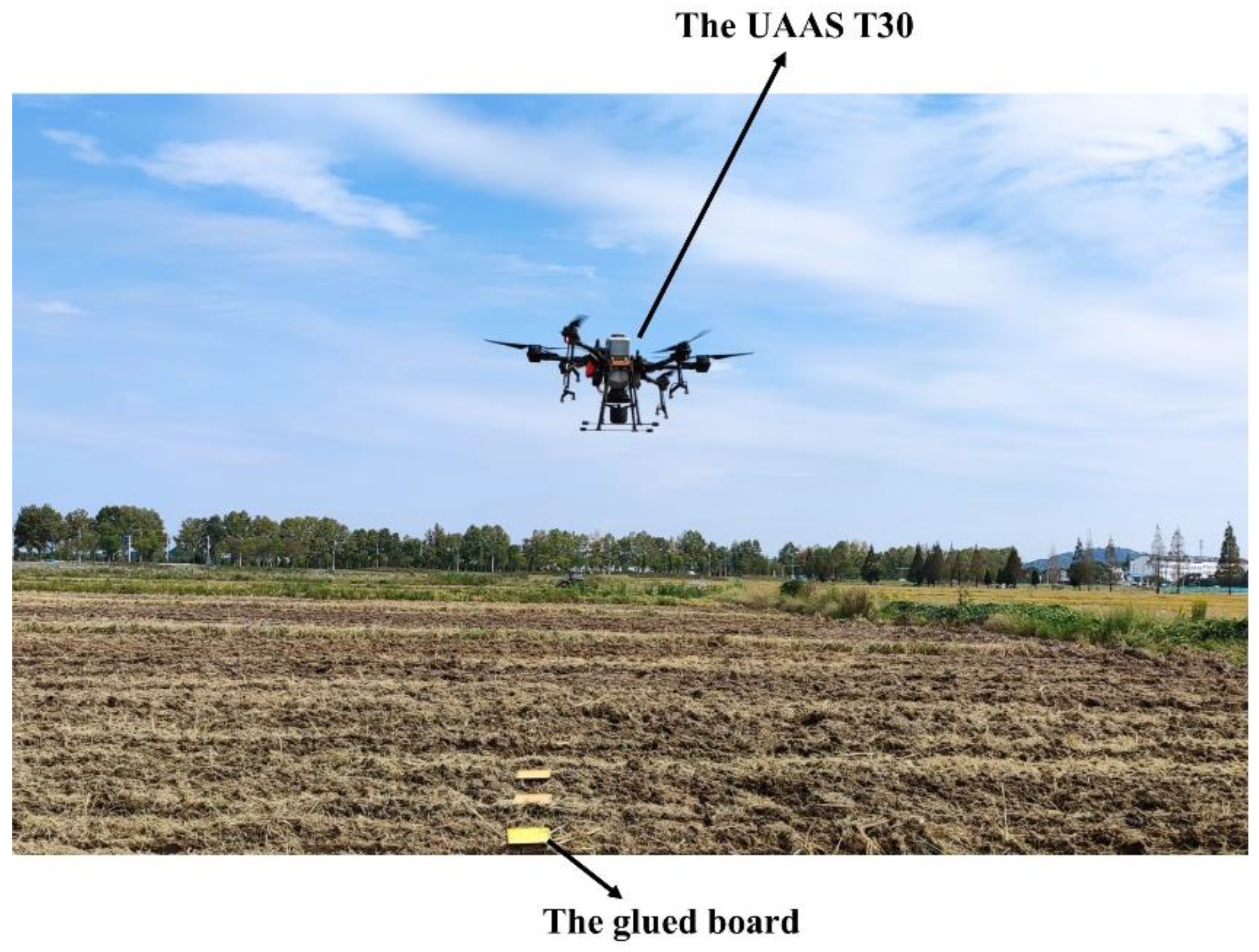
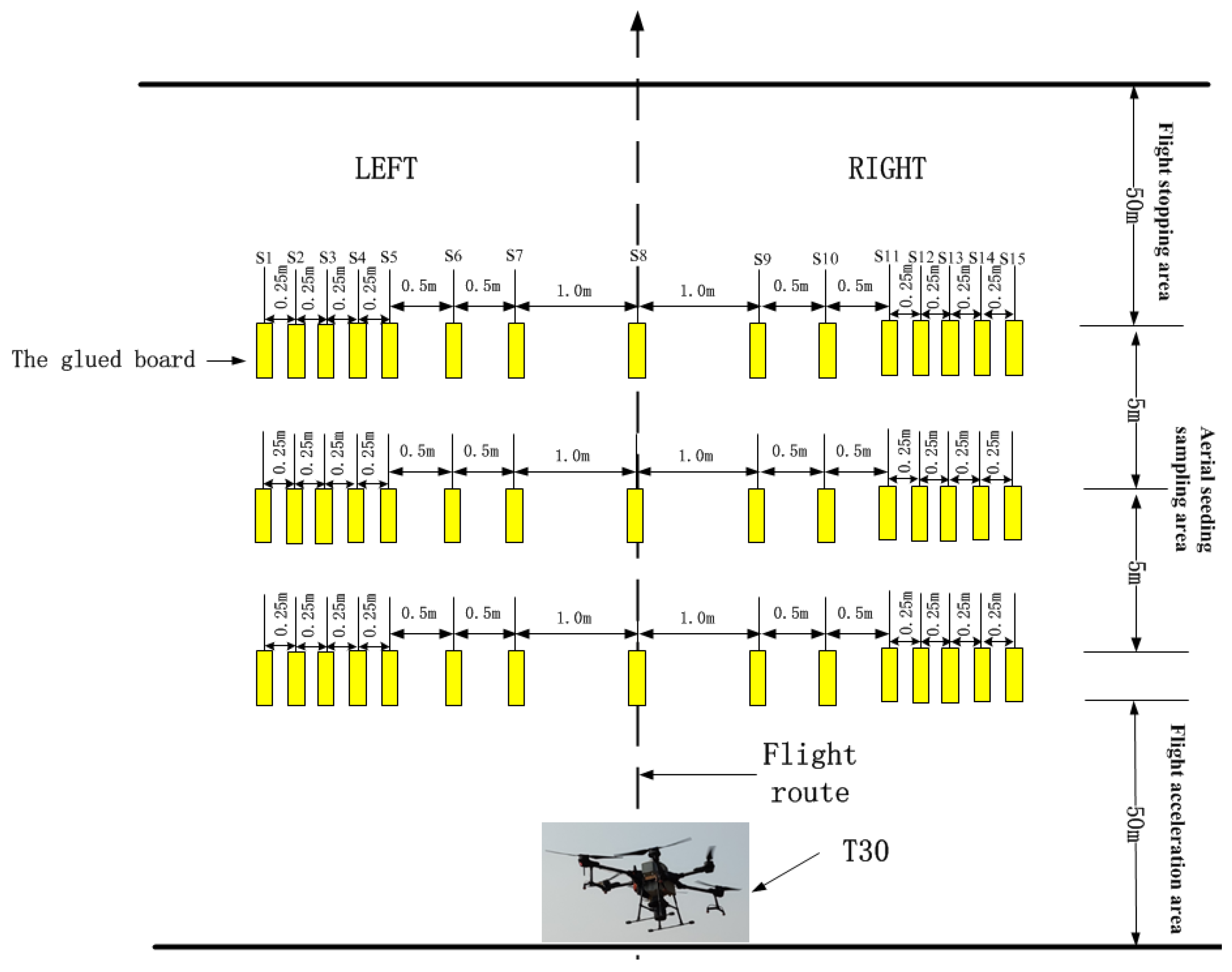
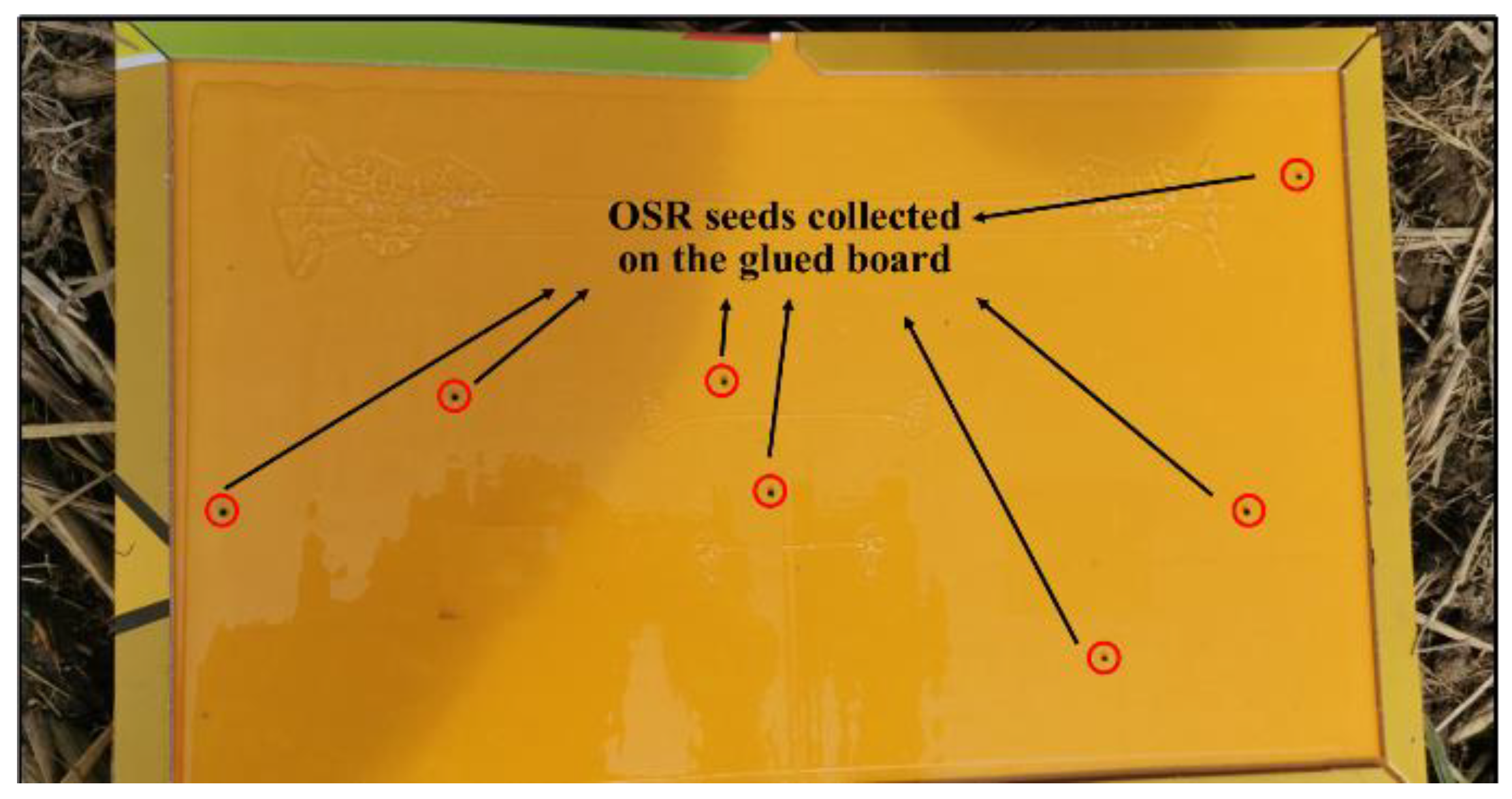
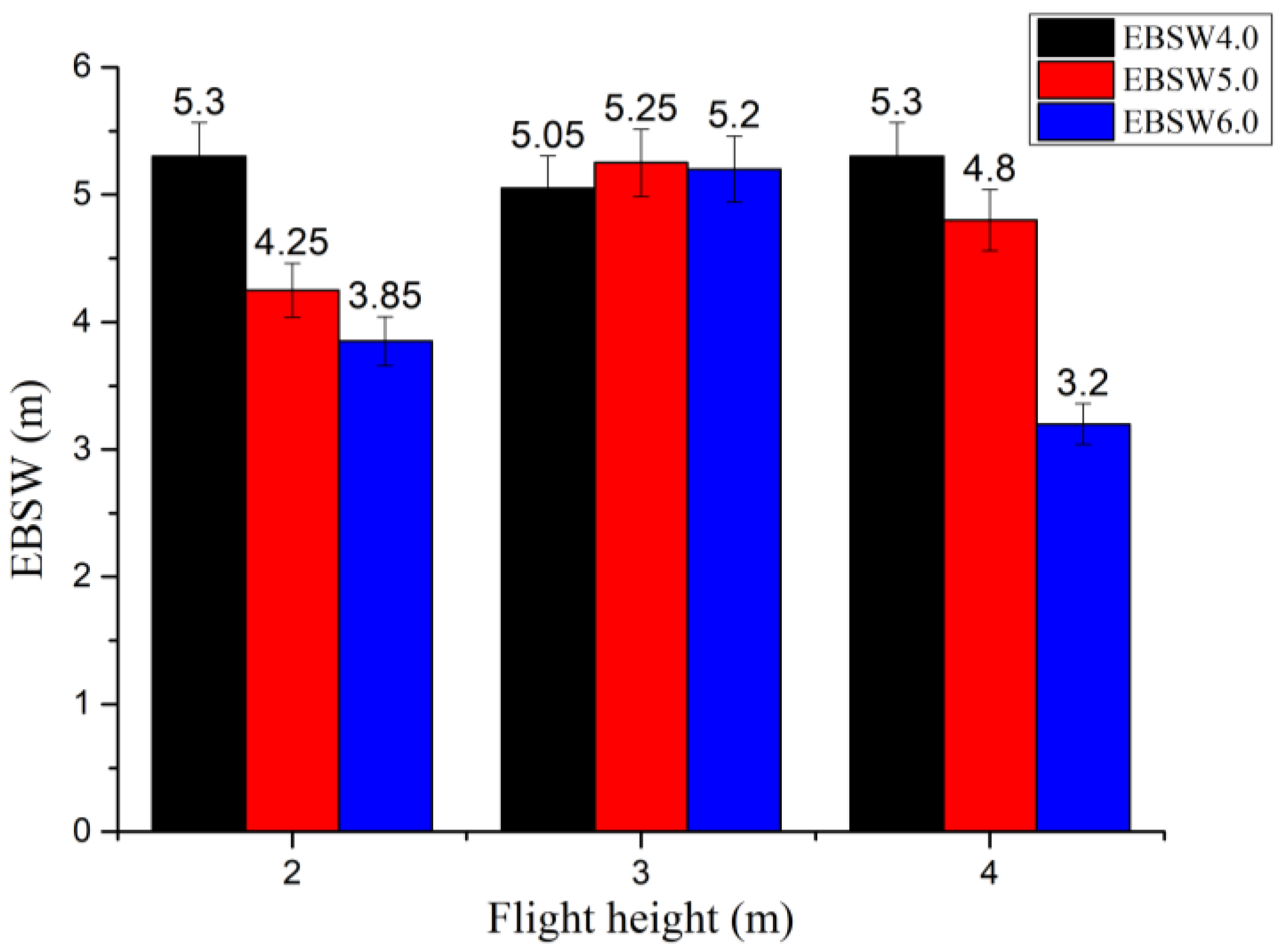
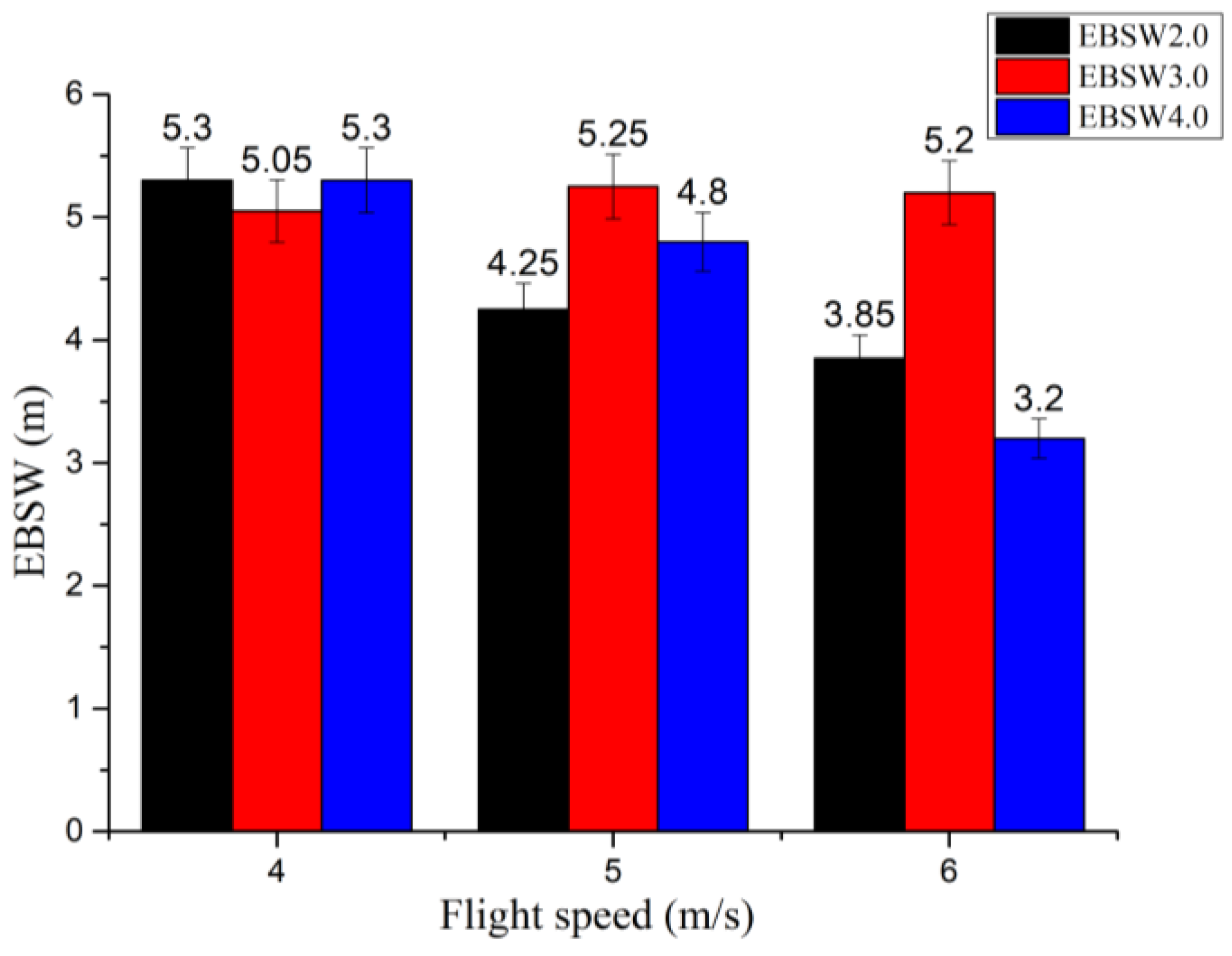
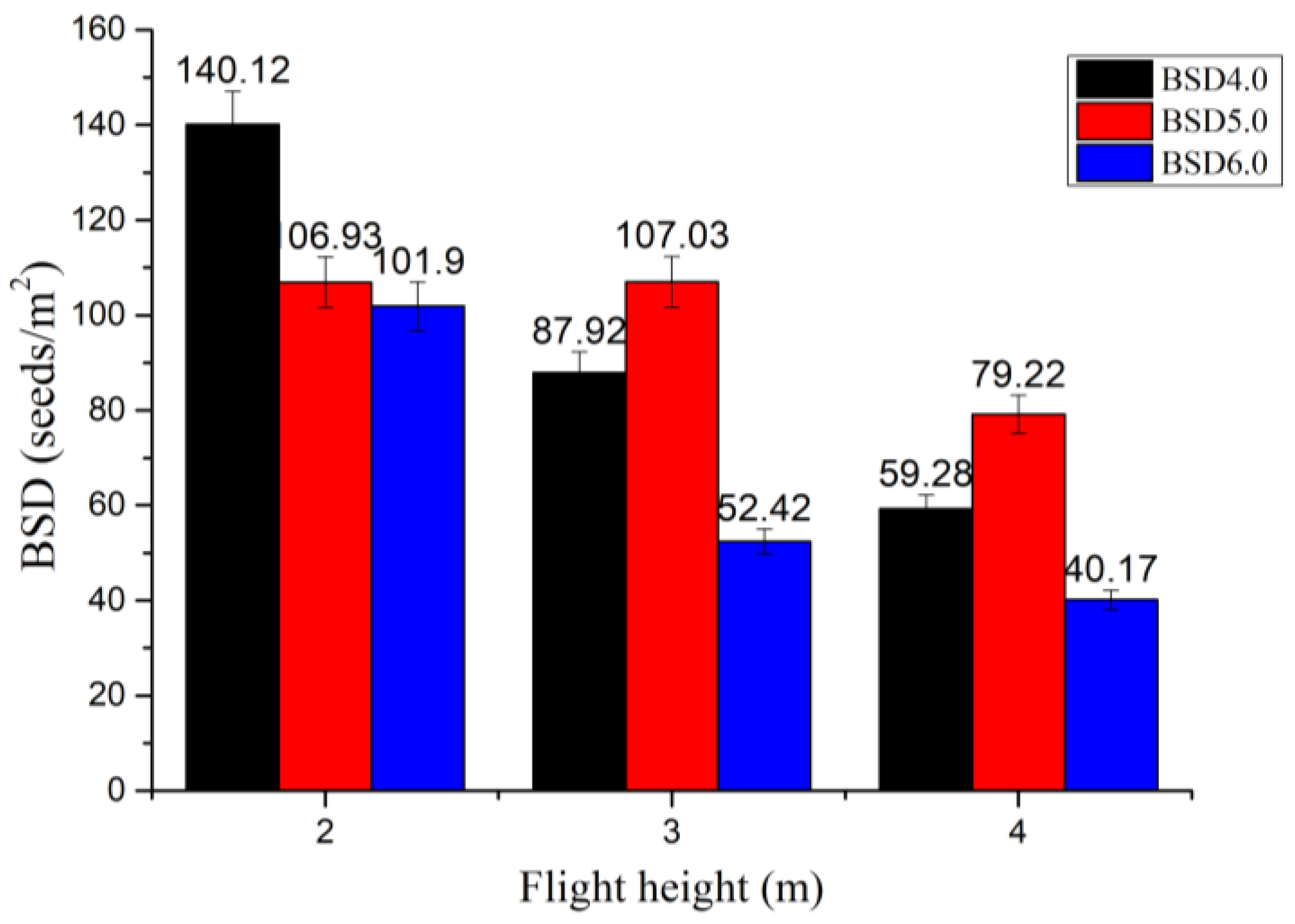
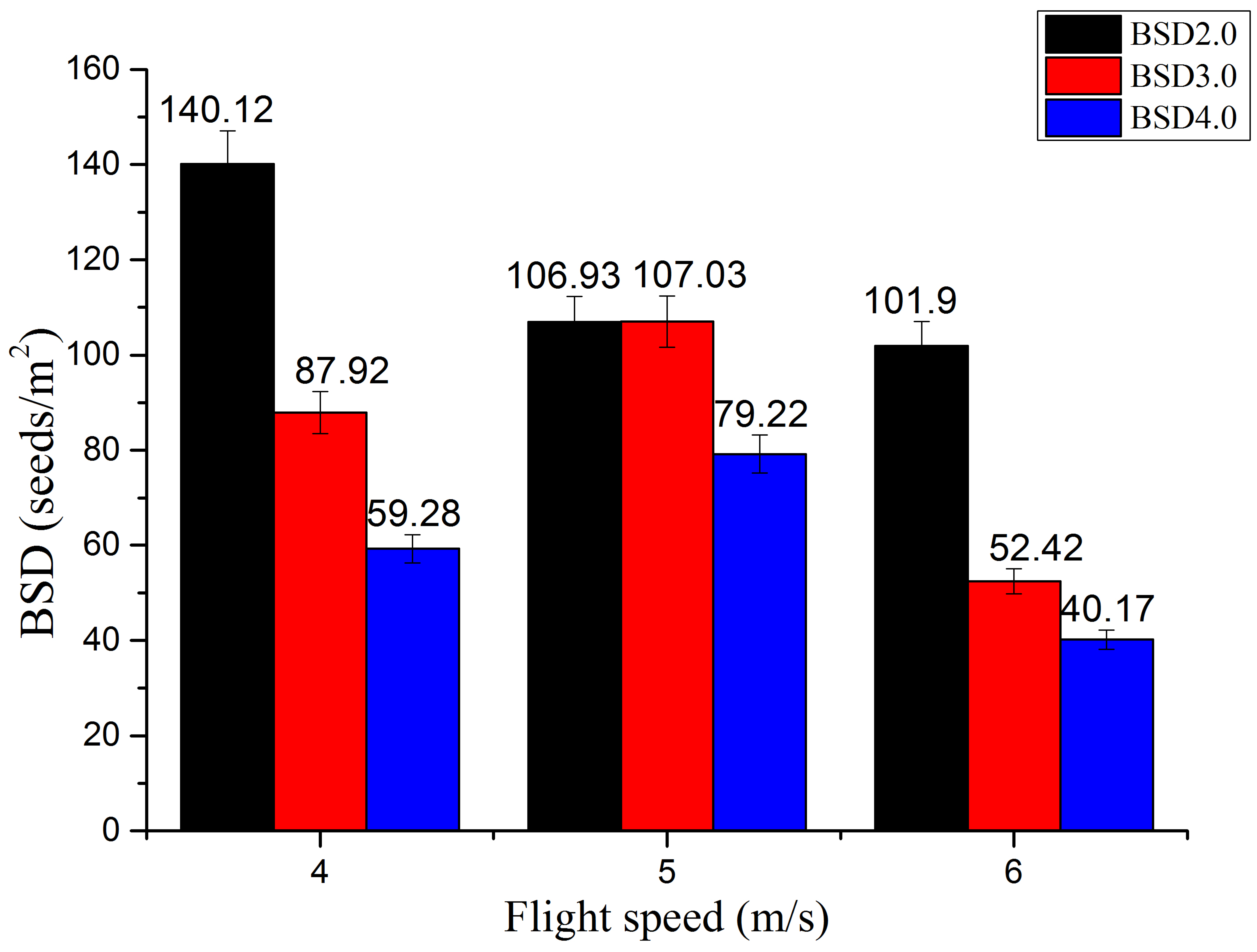

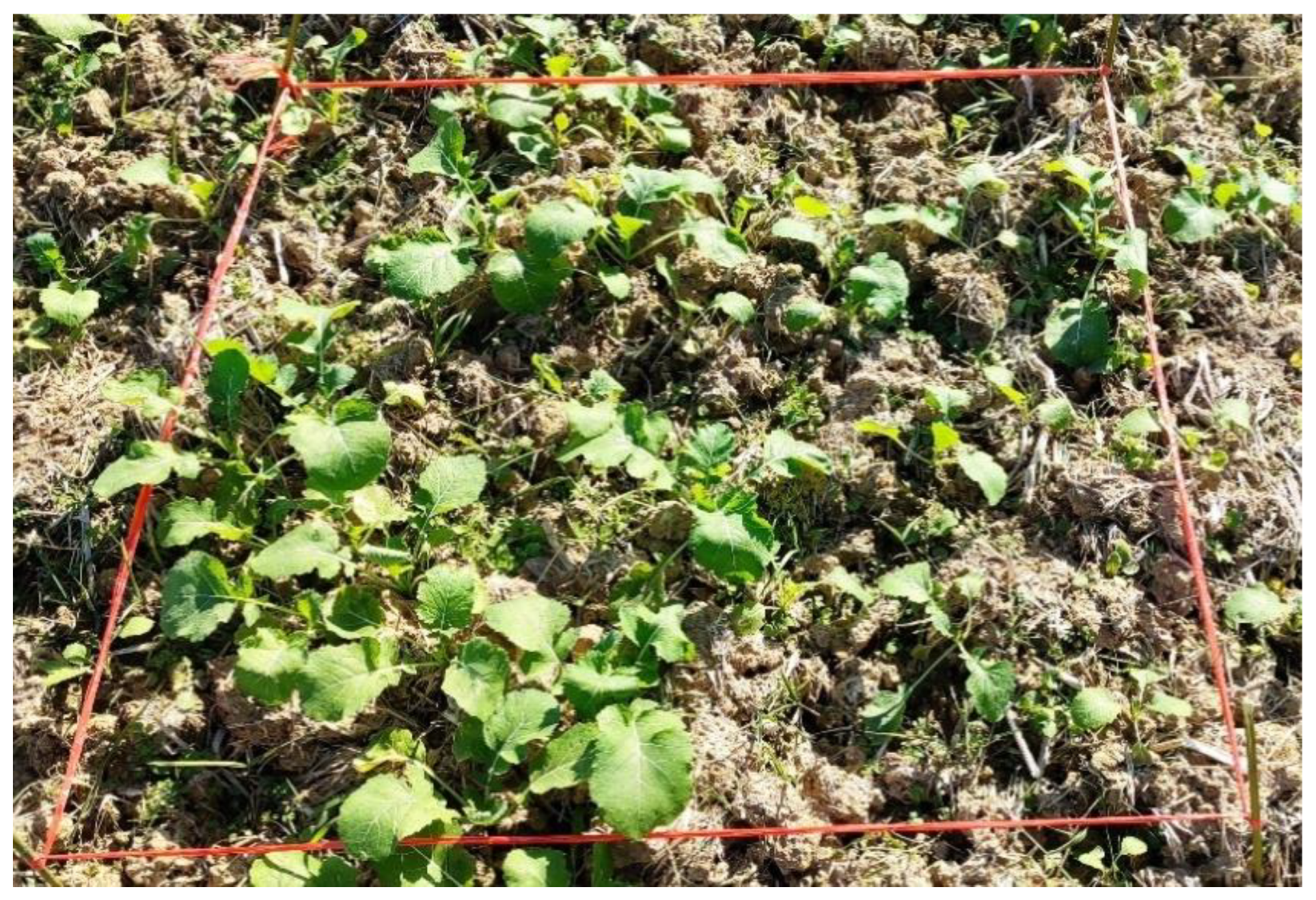
| Items | Parameters |
|---|---|
| UAAS size | 2858 mm × 2685 mm × 790 mm |
| Rotor diameter × Pitch | 38 × 20 inch |
| Battery capacity | 29000 mAh–51.8 V |
| FS | 1.0 –7.0 m/s |
| FH | 0.5–6.0 m |
| Seed box volume | 40 L |
| Aerial seeding rate | 16.67 kg/min (MAX) |
| Treatments | FH/m | FS (m/s) | Aerial Seeding Dosage (kg/ha) |
|---|---|---|---|
| T1 | 2.0 | 4.0 | 6.0 |
| T2 | 2.0 | 5.0 | 6.0 |
| T3 | 2.0 | 6.0 | 6.0 |
| T4 | 3.0 | 4.0 | 6.0 |
| T5 | 3.0 | 5.0 | 6.0 |
| T6 | 3.0 | 6.0 | 6.0 |
| T7 | 4.0 | 4.0 | 6.0 |
| T8 | 4.0 | 5.0 | 6.0 |
| T9 | 4.0 | 6.0 | 6.0 |
| Treatments | Maximum Broadcast Seeding Width/m | EBSW/m | BSD (Seeds/m2) | CV/% |
|---|---|---|---|---|
| T1 | 5.35 | 5.30 | 140.12 | 29.12 |
| T2 | 4.98 | 4.25 | 87.92 | 45.36 |
| T3 | 3.85 | 3.85 | 59.28 | 64.48 |
| T4 | 5.44 | 5.05 | 106.93 | 32.22 |
| T5 | 5.25 | 5.25 | 107.03 | 48.22 |
| T6 | 5.20 | 5.20 | 79.22 | 13.01 |
| T7 | 5.37 | 5.30 | 101.90 | 25.09 |
| T8 | 4.80 | 4.80 | 52.42 | 29.91 |
| T9 | 3.50 | 3.20 | 40.17 | 55.92 |
| Source of Variance | df | F | p-Value | Significance |
|---|---|---|---|---|
| FH | 2 | 19.43 | 0.023 | * |
| FS | 2 | 43.78 | 1.22×10-7 | ** |
| FS×FH | 4 | 12.15 | 5.84×10-5 | ** |
| Source of Variance | df | F | p-Value | Significance |
|---|---|---|---|---|
| FH | 2 | 122.21 | 3.36×10-11 | ** |
| FS | 2 | 290.22 | 0.67 | NS |
| FS × FH | 4 | 33.78 | 0.036 | * |
Publisher’s Note: MDPI stays neutral with regard to jurisdictional claims in published maps and institutional affiliations. |
© 2022 by the authors. Licensee MDPI, Basel, Switzerland. This article is an open access article distributed under the terms and conditions of the Creative Commons Attribution (CC BY) license (https://creativecommons.org/licenses/by/4.0/).
Share and Cite
Zhang, S.; Huang, M.; Cai, C.; Sun, H.; Cheng, X.; Fu, J.; Xing, Q.; Xue, X. Parameter Optimization and Impacts on Oilseed Rape (Brassica napus) Seeds Aerial Seeding Based on Unmanned Agricultural Aerial System. Drones 2022, 6, 303. https://doi.org/10.3390/drones6100303
Zhang S, Huang M, Cai C, Sun H, Cheng X, Fu J, Xing Q, Xue X. Parameter Optimization and Impacts on Oilseed Rape (Brassica napus) Seeds Aerial Seeding Based on Unmanned Agricultural Aerial System. Drones. 2022; 6(10):303. https://doi.org/10.3390/drones6100303
Chicago/Turabian StyleZhang, Songchao, Meng Huang, Chen Cai, Hua Sun, Xiaohui Cheng, Jian Fu, Qingsong Xing, and Xinyu Xue. 2022. "Parameter Optimization and Impacts on Oilseed Rape (Brassica napus) Seeds Aerial Seeding Based on Unmanned Agricultural Aerial System" Drones 6, no. 10: 303. https://doi.org/10.3390/drones6100303
APA StyleZhang, S., Huang, M., Cai, C., Sun, H., Cheng, X., Fu, J., Xing, Q., & Xue, X. (2022). Parameter Optimization and Impacts on Oilseed Rape (Brassica napus) Seeds Aerial Seeding Based on Unmanned Agricultural Aerial System. Drones, 6(10), 303. https://doi.org/10.3390/drones6100303







